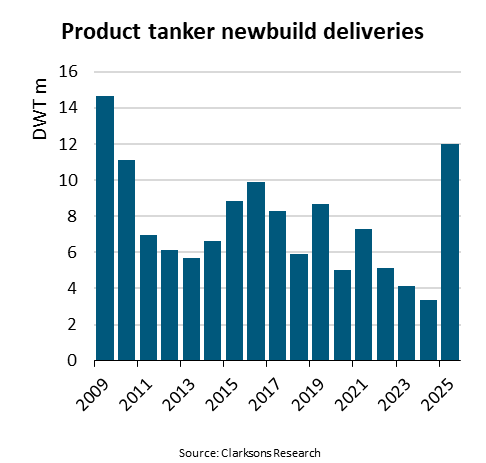According to current delivery schedules, product tanker newbuild deliveries are set to reach 12m deadweight tonnes (DWT) in 2025. Deliveries will therefore jump 256% compared to the 3.4m DWT delivered in 2024. At the same time, deliveries will reach a 16-year high and the second highest on record,” says Niels Rasmussen, Chief Shipping Analyst at BIMCO.
The increase in deliveries follows an increase in contracting of new ships during 2023 and 2024. During those years 551 new ships were contracted with a capacity of 38.7m DWT, significantly up from the yearly average of 122 ships (7.3m DWT) recorded over the previous 10 years.
“The spike in contracting has increased the order book from 10.6m DWT at the beginning of 2023 to 41.2m DWT at the start of 2025. During the same period, the order book to fleet ratio rose from 6% to 22%,” says Rasmussen.
During the last two years, the MR segment attracted the most orders with 278 ships contracted while the LR2 segment saw the most capacity ordered with 19.2m DWT.
The two segments also dominate deliveries for 2025 with 98 MRs and 52 LR2s (4.9m and 6.0m DWT respectively) scheduled. Compared to the fleet size at the beginning of 2025, the scheduled deliveries will add 2%, 6%, 3% and 12% to the DWT capacity of the Handysize, MR, LR1 and LR2 fleet.
Nearly 75% of the ships scheduled for delivery in 2025 were contracted during the last two years. Despite this, only 7% will be capable of using alternative fuels while another 12% are being readied for an eventual retrofit. In the rest of the order book, the share of ships capable of using alternative fuels is 11%.
During the past five years, recycling activity has been slow, and the average ship age has increased by more than 2.5 years since the beginning of 2020. Continued low recycling activity would extend the lifespan of older tankers while slowing the renewal and decarbonisation of the fleet.
“The low recycling activity during the past five years has created an overhang of older ships. Currently, 10% of the fleet’s capacity is comprised of ships older than 20 years. A return to normal recycling patterns would significantly increase recycling but continued Russian sanctions and Houthi attacks in the Red Sea could further delay the retirement of the oldest ships. We estimate that fleet growth will be 5-6% in 2025 while a decline in oil demand growth will likely result in product tanker demand growth ending lower,” says Rasmussen.


 Ningbo Containerized Freight Index Weekly Commentar
Ningbo Containerized Freight Index Weekly Commentar  Ningbo Containerized Freight Index Weekly Commentar
Ningbo Containerized Freight Index Weekly Commentar  Ningbo Containerized Freight Index Weekly Commentar
Ningbo Containerized Freight Index Weekly Commentar  BIMCO Shipping Number of the Week: Bulker newbuildi
BIMCO Shipping Number of the Week: Bulker newbuildi  Ningbo Containerized Freight Index Weekly Commentar
Ningbo Containerized Freight Index Weekly Commentar  Ningbo Containerized Freight Index Weekly Commentar
Ningbo Containerized Freight Index Weekly Commentar